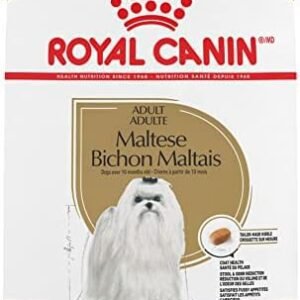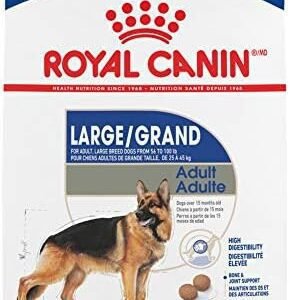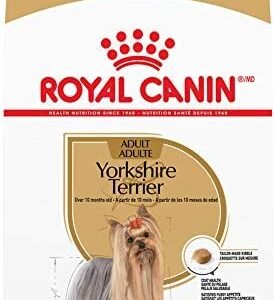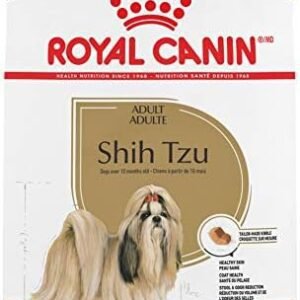Introduction
Did you know that the tomato is not just a staple in countless human dishes, but it’s also hailed as one of the world’s most versatile and widely-used ingredients? From sauces to salads, salsas to soups, the tomato has become a beloved culinary cornerstone in kitchens around the globe. But as we explore the vast and colorful realm of human gastronomy, we must pause and consider the dietary choices we make for our four-legged companions. Can your furry friend partake in the joy of a ripe, juicy tomato? The answer isn’t as straightforward as you might think.
Our dogs, those loyal and ever-hungry members of the family, have unique dietary requirements. What’s good for us doesn’t necessarily translate to canine consumption. It’s essential to be aware of what’s safe and what’s not when it comes to feeding human foods to our pets. In this article, we will delve into the intriguing world of dogs and tomatoes. We aim to answer the question that may have crossed your mind: Can dogs eat tomatoes? Furthermore, we will examine the potential benefits and risks associated with feeding tomatoes to your canine companion. So, let’s embark on this culinary journey, discover the facts, and ensure our furry friends enjoy a healthy and safe diet.
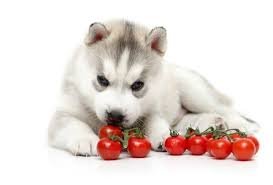
Table of Contents
Can Dogs Eat Tomatoes?
When it comes to our pets, ensuring their safety and well-being is a top priority. And as responsible pet owners, we often wonder about the suitability of various foods in our dogs’ diets. Tomatoes, with their vibrant colors and delightful flavors, have a place in many of our favorite dishes. But can our furry companions also partake in this culinary delight?
Let’s dive into the question: can dogs eat tomatoes? The short answer is yes; tomatoes are not inherently toxic to dogs. However, there are important nuances and considerations to be aware of before sharing this juicy fruit (yes, botanically speaking, a tomato is a fruit) with your canine friend.
Tomatoes come in various shapes, sizes, and colors, and some dogs may indeed enjoy the unique taste they offer. However, there are crucial facts to be mindful of when it comes to dogs and tomatoes. Let’s break down the details.
Nutrition Facts of Tomatoes
Before we delve into the pros and cons of feeding tomatoes to dogs, let’s examine the nutritional profile of these red and yellow beauties. Tomatoes are a rich source of various nutrients, and it’s essential to know what your dog is gaining from this fruit.
Nutrients in Tomatoes
Vitamins: Tomatoes are packed with essential vitamins. They are a good source of vitamin C, which plays a vital role in immune function, and vitamin K, necessary for blood clotting. They also contain vitamin A, which supports vision and skin health.
Minerals: Tomatoes provide minerals such as potassium, a crucial electrolyte that helps maintain proper muscle and nerve function, and manganese, which is essential for enzyme function.
Antioxidants: Tomatoes contain antioxidants, including lycopene, a carotenoid known for its potential cancer-fighting properties.
The Pros: Nutritional Benefits
Tomatoes offer several nutritional benefits for dogs:
Vitamins and Minerals: The vitamins and minerals in tomatoes can contribute to a dog’s overall health. For example, vitamin C aids in collagen formation and can support healthy skin.
Hydration: Tomatoes have high water content, contributing to a dog’s hydration, especially during hot weather.
Low in Calories: Tomatoes are relatively low in calories, making them a healthier treat option for weight-conscious dogs.
The Cons: Potential Drawbacks
As enticing as tomatoes may be, there are potential drawbacks to consider:
Allergies: Just as with humans, some dogs may develop allergies to tomatoes, which can lead to symptoms such as itching, digestive upset, or skin issues.
Digestive Issues: Tomatoes contain substances like solanine and tomatine, which can be problematic for dogs. They may cause gastrointestinal distress when consumed in excess.
Potential Toxicity: The green parts of the tomato plant, including the stems and leaves, contain higher levels of solanine and tomatine and can be toxic to dogs. Additionally, unripe green tomatoes are more likely to cause digestive issues and should be avoided.
In conclusion, while tomatoes can be a healthy addition to your dog’s diet, moderation is key. Feeding your dog small, ripe tomato slices as an occasional treat can be safe and enjoyable for them. However, it’s crucial to be cautious and avoid feeding them the green parts of the tomato plant and unripe green tomatoes. Tomatoes should complement your dog’s primary diet rather than replace it.
Now that we’ve explored the safety aspects and nutritional value of tomatoes for dogs, let’s move on to the next important question: How much tomato can a dog eat?
How much Tomato can a Dog Eat?
In the world of canine culinary adventures, it’s important to approach each new food with care and consideration. The same holds true for tomatoes. While they offer certain nutritional benefits, the key to safely incorporating tomatoes into your dog’s diet is moderation.
Here’s what you need to know about serving tomatoes to your furry friend:
Moderation is Key: When it comes to feeding your dog, moderation is a golden rule. Treats and human foods, including tomatoes, should not constitute more than about 10% of your dog’s daily calorie intake. This means that while sharing a small amount of tomato with your dog can be a delightful treat, it should remain just that—a treat rather than a substantial part of their diet.
Start Small and Observe: Every dog is unique, and their tolerance for different foods varies. If you’re introducing tomatoes into your dog’s diet for the first time, start with a small piece and observe how they react. Keep an eye out for any adverse reactions, such as upset stomach or allergic responses. If your dog experiences any negative effects, it’s best to avoid tomatoes in the future.
Proper Preparation is Crucial: To ensure that the tomato is safe for your dog, it’s essential to prepare it correctly. Remove any green parts, stems, and leaves, which can contain higher levels of solanine and tomatine—substances that can be toxic to dogs. Ripe, red tomatoes are the safest choice. Cut the tomato into small, bite-sized pieces to reduce the risk of choking or digestive issues.
Consider Your Dog’s Size and Breed: The size and breed of your dog can play a significant role in how much tomato they can tolerate. Larger dogs generally have more robust digestive systems and can handle slightly larger portions, while smaller dogs may need smaller servings. Keep your dog’s individual characteristics in mind when deciding how much tomato to offer.
Serving Sizes Based on Weight: To offer a more concrete guideline, here’s a general recommendation for serving sizes based on your dog’s weight:
- Small dogs (under 10 pounds): Half a cherry tomato or less.
- Small to medium dogs (10-30 pounds): One or two cherry tomatoes, or one small slice of a regular-sized tomato.
- Medium to large dogs (30-80 pounds): Up to half of a regular-sized tomato, cut into small pieces.
- Large dogs (80+ pounds): A full tomato, sliced and offered in moderation.
While these guidelines can be a helpful starting point, always remember that individual dogs may have different tolerances and preferences. It’s crucial to adapt the serving size based on your dog’s reactions and feedback. Keep in mind that tomatoes should remain a delightful and occasional addition to their diet.
With this understanding of how much tomato your dog can safely consume, you’re on the right track to sharing this delicious treat without any harm. But what about the risks and potential dangers of feeding tomatoes to dogs? We’ll explore these in the next section.
What are the Risks of Feeding Tomatoes to Dogs?
While tomatoes offer various health benefits, it’s essential to be aware of potential risks when feeding them to your four-legged companion. Understanding these risks allows you to make informed choices and keep your furry friend safe. Let’s explore some of the possible concerns associated with feeding tomatoes to dogs:
Food Allergies in Dogs: Just like humans, dogs can also have food allergies, and tomatoes are not immune to this. Some dogs may be sensitive or allergic to tomatoes, and the allergic reactions can manifest in various ways. It’s crucial to monitor your dog for signs of allergies when introducing tomatoes into their diet.
Short-term Signs of Food Intolerance: Food intolerance is another issue that can affect dogs when they consume tomatoes. Signs of food intolerance can include gastrointestinal distress, such as vomiting, diarrhea, or an upset stomach. If your dog exhibits any of these symptoms after consuming tomatoes, it’s advisable to refrain from offering them in the future.
Hazardous Components in Tomatoes: Tomatoes contain certain components that may pose risks to dogs. Two compounds found in tomatoes, solanine and tomatine, can be toxic to dogs in higher concentrations. These substances are more concentrated in the green parts of the tomato plant, including stems and leaves. While ripe, red tomatoes have much lower levels of solanine and tomatine, it’s still important to remove any green parts to minimize risks.
Signs of Allergic Reactions: Allergic reactions in dogs can vary in severity and may include symptoms like skin rashes, itching, swelling, or gastrointestinal discomfort. If you notice any signs of an allergic reaction after your dog consumes tomatoes, it’s wise to consult your veterinarian for guidance.
Specific Issues and Concerns: Besides the risks mentioned above, some dogs may have particular issues when consuming tomatoes. For example, dogs with pre-existing kidney problems should avoid tomatoes due to their high potassium content. The excess potassium could be harmful in such cases. Always consider your dog’s individual health and dietary requirements.
Signs and Symptoms of Adverse Reactions: It’s important to recognize signs and symptoms of adverse reactions in dogs when they consume tomatoes. These reactions can manifest in various ways, including:
- Upset stomach
- Vomiting
- Diarrhea
- Lethargy
- Allergic reactions (skin rashes, itching, swelling)
- Gastrointestinal distress
Understanding these risks and potential issues is crucial for keeping your dog safe and healthy. While many dogs can enjoy tomatoes without any problems, it’s always a good practice to introduce them gradually and monitor your pet’s response. If you notice any adverse reactions, it’s best to avoid tomatoes in their diet.
With this awareness of the potential risks, you can make an informed decision about whether or not to share tomatoes with your furry friend. But what if you decide to go ahead and offer tomatoes? How can you make this treat more enjoyable for your dog? We’ll explore this in the next section.
How to Feed Tomatoes to Your Dog and Make It More Enjoyable for Them
Feeding your dog tomatoes can be a delightful experience for both you and your furry companion. It’s essential to consider their preferences, dietary needs, and the various ways you can incorporate tomatoes into their meals.
Incorporating Tomatoes into Your Dog’s Diet:

Tomatoes can be integrated into your dog’s diet in a variety of ways. Here are some suggestions on how to do so:
Fresh Tomatoes: You can offer your dog fresh, ripe tomatoes as a healthy snack. Ensure you remove the green parts, such as stems and leaves, and cut the tomatoes into small, bite-sized pieces. This allows for easy consumption and minimizes the risk of choking.
Frozen Tomato Treats: On a hot summer day, frozen tomato treats can be a refreshing option for your dog. Puree ripe tomatoes and freeze them in ice cube trays for a cool and tasty snack. Remember to use tomato in moderation, as too much of any treat can lead to weight gain.
Tomato as a Food Topper: One way to make your dog’s meals more exciting is to use tomatoes as a food topper. Chop or puree tomatoes and sprinkle them over your dog’s regular food. This adds a burst of flavor and nutrition to their meals.
- Homemade Tomato-Based Recipes: Get creative in the kitchen by preparing homemade tomato-based treats or snacks. You can make tomato-based biscuits or incorporate tomatoes into homemade dog food recipes. Remember to avoid using ingredients that are harmful to dogs, such as onions or garlic.
Enhancing Your Dog’s Dining Experience:
Incorporating tomatoes into your dog’s diet not only adds flavor but also provides a dose of nutrients. Here are some ways to enhance your dog’s dining experience while ensuring their meal is nutritious and enjoyable:
Balanced Diet: Always consider tomatoes as a supplement to your dog’s primary diet. They should not replace essential dog food, which provides the necessary nutrients for your dog’s health.
Serving Sizes: The serving size of tomatoes should be appropriate for your dog’s weight and size. Smaller dogs will require smaller amounts. Start with a small portion and observe how your dog responds before increasing the quantity.
Observation: Pay attention to how your dog reacts to tomatoes. While some dogs may love the taste, others may be indifferent. If you notice any adverse reactions, such as upset stomach, discontinue the use of tomatoes in their diet.
- Variety: Mix things up by combining tomatoes with other dog-friendly fruits and vegetables. This not only diversifies their diet but also provides a broader range of nutrients.
Homemade Treat Ideas:
If you enjoy cooking for your furry friend, here are some ideas for homemade dog treats featuring tomatoes:
Tomato and Cheese Biscuits: Create delicious, tomato-infused biscuits by combining whole wheat flour, grated cheese, and a small amount of tomato paste. Bake them until golden brown, and your dog will appreciate this cheesy delight.
Tomato and Chicken Dog Food: Prepare a nutritious meal by mixing cooked chicken, steamed vegetables, and diced tomatoes. This balanced dish is packed with flavor and nutrients.
Frozen Tomato Delight: Blend ripe tomatoes with a small amount of yogurt, pour the mixture into ice cube trays, and freeze. Your dog will love licking this tasty, frozen treat.
Remember that while tomatoes can be an exciting addition to your dog’s diet, moderation is key. As we’ve discussed earlier, tomatoes carry certain risks, and consuming them in excess can lead to adverse effects. By following these guidelines and getting creative in the kitchen, you can offer your furry friend a tasty and nutritious treat while keeping them safe and happy.
Now that we’ve explored the various aspects of feeding tomatoes to dogs, including risks, preparation, and ways to make it enjoyable for them, it’s time to address some of the most frequently asked questions regarding this topic. In the next section, we’ll provide answers to common queries about dogs and tomatoes.
10 FAQs About Dogs Eating Tomatoes
As we delve deeper into the topic of feeding tomatoes to dogs, it’s common to have questions about the safety, preparation, and potential benefits or risks associated with this practice. To address some of the most frequently asked questions regarding dogs and tomatoes, we’ve compiled a list of ten FAQs along with detailed answers:
1. Can dogs eat tomatoes, and are they safe?
Dogs can indeed eat tomatoes, but it’s crucial to exercise caution. Tomatoes are considered safe for most dogs in small quantities. However, they should be prepared and served correctly to avoid potential issues, such as digestive upset. Also, keep in mind that some dogs may be more sensitive to tomatoes than others. Always observe how your dog reacts to them and consult your veterinarian if you have any concerns.
2. Can dogs eat all parts of the tomato plant?
No, not all parts of the tomato plant are safe for dogs. The green parts, such as stems, leaves, and unripe tomatoes, contain a substance called solanine, which can be toxic to dogs. Ensure that you remove all green parts before feeding tomatoes to your dog.
3. Can dogs eat tomato sauce or ketchup?
While ripe, fresh tomatoes are generally safe for dogs, tomato sauce or ketchup may not be the best choice. These products often contain additional ingredients, such as spices, sugar, and salt, which can be harmful in excess. If you plan to share a tomato-based product with your dog, choose one with minimal additives or make your own to control the ingredients.
4. Can tomatoes cause allergies in dogs?
Tomatoes can cause allergies or food sensitivities in some dogs. If you notice any signs of an adverse reaction, such as itching, vomiting, or diarrhea after feeding your dog tomatoes, discontinue their use and consult your veterinarian.
5. Are there any nutritional benefits to feeding tomatoes to dogs?
Tomatoes offer some nutritional benefits to dogs. They are a good source of vitamins and minerals, such as vitamin C, potassium, and folate. These nutrients can support your dog’s overall health, but it’s important to view tomatoes as a supplement to their primary diet and not a substitute.
6. Can dogs eat cherry tomatoes?
Cherry tomatoes, like other varieties, can be safe for dogs if served in moderation and without any green parts. Chop them into small pieces to prevent choking hazards and offer them as an occasional treat.
7. How should I prepare tomatoes for my dog?
To prepare tomatoes for your dog, ensure you remove any green parts, cut them into small, manageable pieces, and serve them plain, without any additives like salt or seasonings. Avoid feeding canned tomatoes, which can contain added salt or preservatives that are not suitable for dogs.
8. Are there any long-term health risks associated with feeding tomatoes to dogs?
Feeding your dog small amounts of ripe tomatoes should not pose any long-term health risks. However, excessive consumption can lead to digestive issues and other complications. As with any treat, moderation is key.
9. What should I do if my dog consumes a large amount of tomatoes or shows signs of an adverse reaction?
If your dog consumes a large quantity of tomatoes or exhibits signs of an adverse reaction, such as vomiting, diarrhea, or unusual behavior, contact your veterinarian immediately. They can provide guidance based on your dog’s specific situation.
10. Are there alternatives to tomatoes that I can offer my dog as a treat or supplement?
Yes, there are many dog-friendly fruits and vegetables that can serve as alternatives to tomatoes. Some options include apples, carrots, blueberries, and green beans. These treats are lower in acidity and are less likely to cause digestive issues. Always remember to serve these alternatives in moderation.
In summary, while tomatoes can be safely incorporated into your dog’s diet, it’s essential to proceed with caution and adhere to the guidelines discussed in this article. Feeding them in moderation, removing any green parts, and observing your dog’s reactions are key steps to ensure their safety and well-being. If you have any doubts or concerns about your dog’s diet, consult your veterinarian for professional advice.
Now that we’ve addressed these common questions, let’s wrap up our exploration of dogs and tomatoes with a conclusion that summarizes the key points and offers some final thoughts and recommendations for your readers.
Conclusion
In this comprehensive guide, we’ve unraveled the intriguing topic of whether dogs can eat tomatoes. As we wrap up our discussion, it’s essential to reiterate the key takeaways.
Tomatoes, when handled with care, can be a part of your dog’s diet. These red gems are not toxic, and many dogs enjoy the taste. However, serving them safely is crucial. Remember to remove any green parts, which can contain harmful substances. Moderation is the golden rule; tomatoes should complement your dog’s primary diet, not replace it.
While tomatoes have nutritional benefits, they’re not essential for your dog’s health. As with any treat, excessive consumption can lead to digestive issues and other complications. Dogs have varying levels of sensitivity, so it’s essential to observe their reactions closely.
If you’re exploring alternative treats, consider options like apples, carrots, blueberries, or green beans. These foods are lower in acidity and less likely to cause digestive problems. Always ensure these treats are served in moderation and without seeds or cores.
We hope this guide has equipped you with the knowledge needed to make informed decisions about including tomatoes in your dog’s diet. Remember that your dog’s well-being is a priority, and consulting your veterinarian for personalized advice is a prudent choice. Do you have any questions or experiences related to feeding tomatoes to your dog? We’d love to hear from you in the comments section below or on our social media platforms. Your insights can benefit fellow dog owners and their furry companions.





















